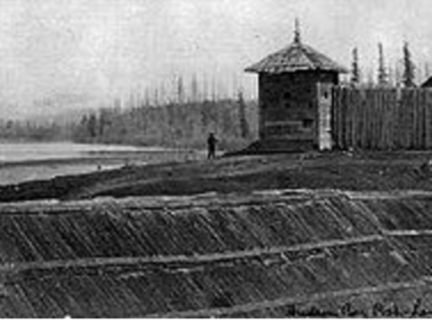1800's - Trade and Expansion

The 1800's in British Columbia were notable for trade and expansion. In this era, British Columbia went from being a trading outpost to a newly formed province of Canada. The Northwest Company and Hudson's Bay Company established a number of trading posts and forts throughout British Columbia, including Fort St. John, Fort George and Fort Langley. The two companies eventually merged. James Douglas, of Scottish and Guyanese origins, became British Columbia's first colonial Governor.
- In 1803, Maquinna, chief of the Nuu-chah-nulth people of Nootka Sound, led an attack on the American trading vessel, the Boston.
- In 1808, Simon Fraser began an expedition of the present day Fraser River.
- In 1821, the North West Company and Hudson's Bay Company merged, creating three new trading regions, New Caledonia, Thompson River Watershed and Columbia District.
- In 1846, the British relinquished any claim to territory south of the 49th parallel in signing the Oregon Treaty.
- In 1847, the discovery of gold on the Fraser River attracted over 30,000 miners and dreamers, marking the start of the Gold Rush.
- In 1858, James Douglas became Governor of the newly formed colony of British Columbia.
- In 1871, British Columbia became the sixth province to enter the Confederation of Canada.
- In 1885, Canadian Pacific completed the transcontinental railway from Montreal to Port Moody.
Useful Websites
Digital Library Resources
Recommended Titles
Britannia's Navy on the West Coast of North America, 1812-1914
979.5 G69b
2016
The influence of the Royal Navy on the development of British Columbia and the Pacific Northwest was both effective and extensive.
British Columbia and Yukon Gold Hunters: A History in Photographs
971.102 W14b
2015
Although the 1848 discovery of gold in California was the first bonanza to trigger an invasion of migrants to North America's Pacific Coast, it was relatively short-lived. Soon, grander findings farther north led to an even greater influx of gold hunters. In 1851, a twenty-seven-ounce gold nugget was found on Haida Gwaii, ushering in fifty years of gold fever that brought a wave of Californians to the Fraser River and then farther inland to the gold-laden creeks of the Cariboo.
Epic Wanderer: David Thompson and the Mapping of the Canadian West
971.2 T46j
2003
Epic Wanderer , the first full-length biography of David Thompson, is set in the late eighteenth and early nineteenth centuries against a broad canvas of dramatic rivalries -- between the United States and British North America, between the Hudson's Bay Company and its Montreal-based rival, the North West Co.
James Douglas: Father of British Columbia
971.1 D73f
2009
James Douglas's story is one of high adventure in pre-Confederation Canada. It weaves through the heart of Canadian and Pacific Northwest history when British Columbia was a wild land, Vancouver didn't exist, and Victoria was a muddy village.
Northwest History Index
This card index in Special Collection provides access to the Northwest History Collection, a heritage collection covering the early history and exploration of British Columbia and the Pacific Northwest.
The collection includes:
- magazine and newspaper articles
- pamphlets
- books
- chapters in books
- many other resources
As of August 1998, no new material has been added to the Northwest History Index. It is continued by the British Columbia Index.


